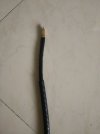FMs who are following my post may know by now that i am a cable freak and at times go nuts trying to perfect it. Family members feel that i need help  - . After many years of working with different cable geometries, dielectrics, materials i have discovered that no single solution will be suitable for most setups (well atleast mine). I have tried copper, silver - stranded, single core with varying awg sizes and have used pvc, air, teflon dielectrics, have used enameled copper, tinned copper - stranded as well as single core, telephone cables .... the list is endless with various configurations and combinations.
- . After many years of working with different cable geometries, dielectrics, materials i have discovered that no single solution will be suitable for most setups (well atleast mine). I have tried copper, silver - stranded, single core with varying awg sizes and have used pvc, air, teflon dielectrics, have used enameled copper, tinned copper - stranded as well as single core, telephone cables .... the list is endless with various configurations and combinations.
What i have realized that with some combinations the sound stage is much faster than it need to be and usually the high frequency appears to be ahead of the low frequency. This is even when my speakers are time aligned in geometry and i have measured delay from 4mm to 8mm in arrival time. This cause a severe phase shift in my otherwise accurate setup. This lead me to think about various other materials (metals) that could be used other than just copper and / or silver to slow down the HF energy a bit.
This led me to discover metals like aluminium, tin, chromium, zinc, steel, nickle along with copper and silver. The conductivity, resisitivity and skin depth of all these material differs so need to arrive at the proper guage size when used in combination. For instance in my speaker cable i have found that using only copper wires tend to make them more forward sounding and aggressive in the high-end. But when i used copper - along with aluminium, zinc, steel and silver with proper sizing there is a kind of perfect balance to the sound stage with everything else remaining same. The sound becomes more netural, balanced and open. This is due to no skin effect in aluminium wires and so the LF & MF arrive at the same time as the HF and the signal pass through the entire conductor. Its after many permutation and combinations i was able to arrive at the right recipe of what will constitute an interconnect or a speaker cable.
I have ordered some material to finalize and complete my design to help me make my own first batch of IC cables and that should be ready in 2 more weeks. My speaker cable is already under use since past one week and i am enjoying every bit of them and always wonder why i did not go this route earlier. That's certainly for its keep. I may not intend to make more than 5 pairs of these interconnect cables in this batch due to want of funds and my own requirement / needs.
Thanks for looking.
What i have realized that with some combinations the sound stage is much faster than it need to be and usually the high frequency appears to be ahead of the low frequency. This is even when my speakers are time aligned in geometry and i have measured delay from 4mm to 8mm in arrival time. This cause a severe phase shift in my otherwise accurate setup. This lead me to think about various other materials (metals) that could be used other than just copper and / or silver to slow down the HF energy a bit.
This led me to discover metals like aluminium, tin, chromium, zinc, steel, nickle along with copper and silver. The conductivity, resisitivity and skin depth of all these material differs so need to arrive at the proper guage size when used in combination. For instance in my speaker cable i have found that using only copper wires tend to make them more forward sounding and aggressive in the high-end. But when i used copper - along with aluminium, zinc, steel and silver with proper sizing there is a kind of perfect balance to the sound stage with everything else remaining same. The sound becomes more netural, balanced and open. This is due to no skin effect in aluminium wires and so the LF & MF arrive at the same time as the HF and the signal pass through the entire conductor. Its after many permutation and combinations i was able to arrive at the right recipe of what will constitute an interconnect or a speaker cable.
I have ordered some material to finalize and complete my design to help me make my own first batch of IC cables and that should be ready in 2 more weeks. My speaker cable is already under use since past one week and i am enjoying every bit of them and always wonder why i did not go this route earlier. That's certainly for its keep. I may not intend to make more than 5 pairs of these interconnect cables in this batch due to want of funds and my own requirement / needs.
Thanks for looking.


